We have rounded the final turn and are in the homestretch of our collections move! Consequently, we’re seeing a lot more of this:

And of this:

And a lot less of these!

We have rounded the final turn and are in the homestretch of our collections move! Consequently, we’re seeing a lot more of this:

And of this:

And a lot less of these!

It’s week five of our collections move, and the Rubenstein is a flurry of activity. We won’t sit down until all of our collections are moved!
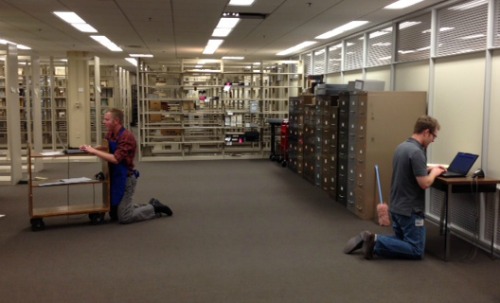
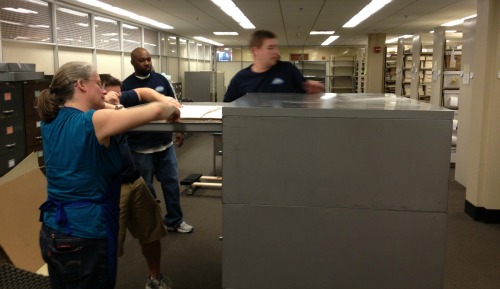
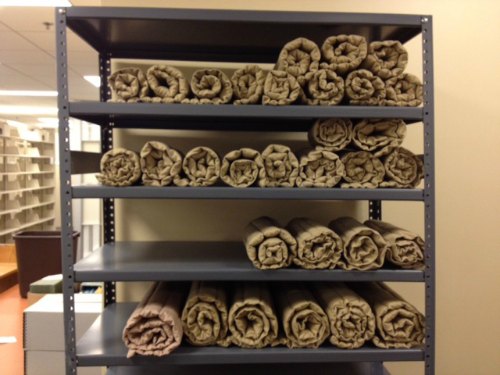
While researching a reference request among the William Mahone Papers, an interesting piece of ephemera was discovered that gives us a peek at the opinions of one African American politician regarding the lingering shadows of the Confederacy almost 15 years after the Civil War ended. On December 20, 1879, a letter was sent to Mahone, who was the recently elected US Senator for the state of Virginia.
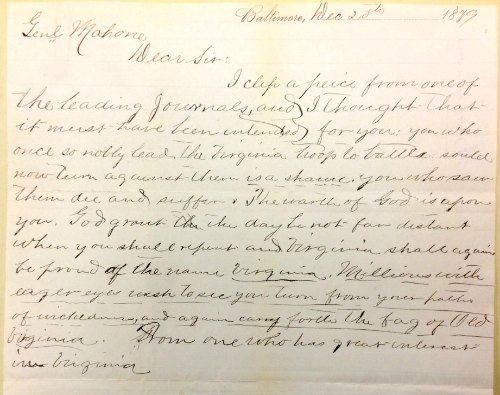

The author of the letter, who decided not to sign their name, seemed to take issue with Mahone and the idea that he had turned his back on the Confederacy. He/she noted, “…you who once so nobly lead the Virginia troops to battle could now turn against them is a shame…The wrath of God is upon you.” What could have stirred up such vitriol from the sender of this brief but contemptuous letter? The answer lies in the article that was attached to the letter.
The clipping, though undated, was likely printed in the same year. The bold call of State Senator Cephas Davis, himself a former slave, for a resolution “prohibiting the use of the words one-legged, two-legged or four-legged Confederate soldier,” was undoubtedly newsworthy. Davis would only serve one year in the VA State Senate, but it is interesting that he not only saw himself a victor in the Civil War, but also an agent to ensure the Confederacy would not be remembered.
Post contributed by John Gartrell, Director of the John Hope Franklin Research Center for African and African American History and Culture. This is the first in a series of posts on interesting documents in our collections to celebrate Black History Month.
Welcome to the fourth installment of the photo diary of the Rubenstein Library’s move. Like proud new parents, we present to you the firsts from this week of the collections move…


Helpful Links:
Welcome to the third installment of the photo diary of the Rubenstein Library’s move. Today marks the first day of our collections move. Time to use our spiffy new aprons and fill up all of those book trays!

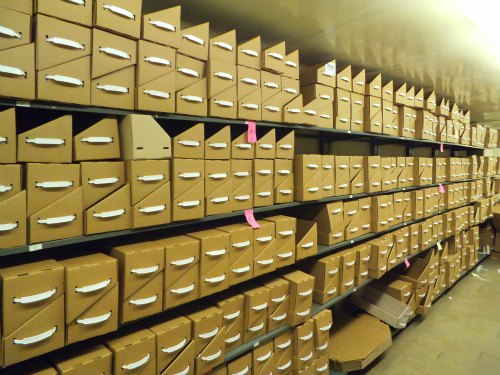
Helpful Links:
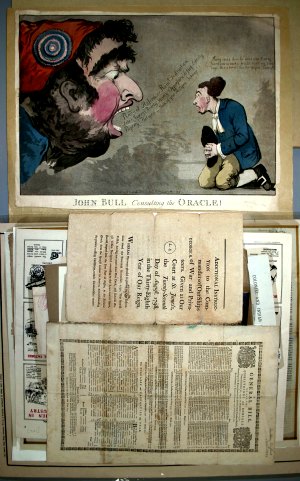 Conservation is nearing the end of a project that we have been working on since 2009, the broadside collection. In addition to broadsides, this collection includes thousands of posters, handbills, maps, diplomas, and a variety of paper ephemera. We in the conservation department have been coordinating with the Digital Production Center (DPC) to enable the safe handling of these materials during digitization.
Conservation is nearing the end of a project that we have been working on since 2009, the broadside collection. In addition to broadsides, this collection includes thousands of posters, handbills, maps, diplomas, and a variety of paper ephemera. We in the conservation department have been coordinating with the Digital Production Center (DPC) to enable the safe handling of these materials during digitization.
Many of the broadsides come to us encapsulated in Mylar that has been sealed with sticky tape. The items must be removed from the encapsulation prior to digitization, and this step also gives us the chance to repair damage that might grow worse with handling during digitization. Many of the broadsides are extremely brittle, and so there are often tears to mend.
The items are organized in folders by state or country, and it is always a surprise to open a folder and see what’s inside. So many of the items are historically fascinating and visually beautiful! To the right is a folder from Britain containing government notices and a caricature print from 1798.
The British folder also contained some much later posters from World War II (below).
This folder of items from Brazil contained broadsides from the Constitutionalist Revolution of 1932.
Also included in this batch of broadsides were highly elaborate diplomas, some on silk with embroidery and some with wax seals and ribbons.
It’s been fun treating such beautiful and fascinating items. Take a closer look at them all in the newly digitized Broadsides and Ephemera Collection!
To see more about this project (including a video), check out our posts at Preservation Underground:
http://blogs.library.duke.edu/preservation/2011/02/19/building-the-broadside-digital-collection/
http://blogs.library.duke.edu/preservation/2010/07/09/heres-your-mule/
http://blogs.library.duke.edu/preservation/2012/04/20/1091-project-digitization-and-conservation/
Post contributed by Grace White, Conservator for Special Collections, as part of our ongoing “In the Conservation Lab” series.

The Hanukkah celebrations of 1981 were especially meaningful for Débora Benchoam and Rabbi Marshall T. Meyer. Benchoam had just been released from four years of brutal imprisonment during Argentina’s “Dirty War,” thanks in large part to the efforts of Meyer. She sent this card to Meyer on 26 November 1981. The card and the letter it contains have been digitized and are available for viewing in Duke’s Digital Collections.
This card is held in the Human Rights Archive‘s Marshall T. Meyer Papers, documenting Meyer’s tireless human rights activism. To learn more about the story of Benchoam and Meyer, see the online exhibit “I Have No Right to Be Silent: The Human Rights Legacy of Marshall T. Meyer” and this 2009 interview with Benchoam.
Post contributed by Will Hansen, Assistant Curator of Collections.
Thanks to all of the students who came to the Rare Book Room for our special study hall yesterday! We hope the golden light and monumental tomes inspired you. And don’t forget to grab a cookie or two at tonight’s study break in the Perkins lobby!
Photo by Kate Collins, Research Services Librarian.
In this month’s update of the Content, Context, and Capacity Project at Duke, we examine the context of an issue of the DRIVE Reporter, a publication of the International Brotherhood of Teamsters. The first page of this issue includes a memorial to President John F. Kennedy and an article about President Lyndon Johnson’s new call for Congress to act on civil rights legislation. Immediately, two questions come to mind: Why are these issues appearing in a labor union’s publication? And why does this publication appear in the papers of Basil Lee Whitener, a Congressman from North Carolina?
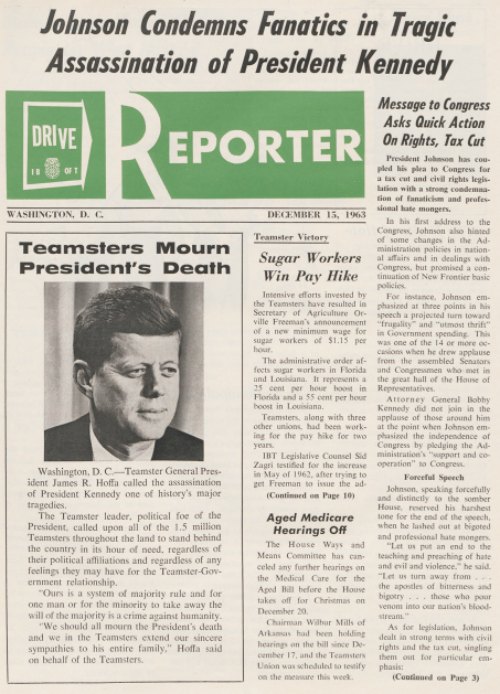
The first question ties to the stated mission of the International Brotherhood of Teamsters. Led by its controversial president Jimmy Hoffa, the Teamsters launched DRIVE (Democratic, Republican, Independent Voter Education) in 1959 to educate its members about labor issues and pending legislation. Both the death of President Kennedy and Johnson’s proposals qualified as issues that would affect labor in the immediate future. In addition, the Teamsters had fought for the equality of African-Americans in the workplace. Thus, the inclusion of a story on civil rights legislation made sense in terms of the scope of the Teamsters’ mission.
Committee assignments explain why this publication appears in the papers of Basil Lee Whitener. As a member of the House Judiciary Committee, Whitener reviewed the federal trial of Jimmy Hoffa that occurred in 1964. This publication, along with other Teamsters information, was gathered by Whitener and his staff as research files for the trial proceedings. If Whitener had not been a member of that committee in 1964, the CCC Project would not have access to these rich Hoffa files.
To learn more about the CCC Project and how context plays a role in the history of the LCRM, please visit CCC on Facebook.
The grant-funded CCC Project is designed to digitize selected manuscripts and photographs relating to the long civil rights movement. For more about Rubenstein Library materials being digitized through the CCC Project, check out previous progress updates posted here at The Devil’s Tale!
Post contributed by Josh Hager, CCC Graduate Assistant.
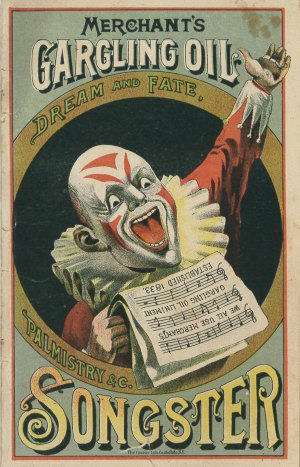
We’ve seen many advertising campaigns of yesteryear here at the Rubenstein Library, thanks to the John W. Hartman Center for Sales, Advertising, and Marketing History. Our History of Medicine Collections contain many examples of promotional items for patent medicines and related remedies. And the Library holds an extensive collection of American songsters, or ephemeral booklets of song lyrics popular in the nineteenth century. But never have we seen more terrifying examples of any of these genres than the Merchant’s Gargling Oil Songsters, which feature scary clowns on their covers.
We have the Merchant’s Gargling Oil Co. to thank for these frightful specimens. The Hagley Museum and Library’s online exhibit on patent medicines tells us that the oil was “primarily used as a topical ointment to treat horses and other animals for burns, scalds, sprains, and bruises,” but could also be used to treat other odd ailments, from foot rot to mange. The oil was not, apparently, gargled.
We know what you’re asking: why use scary clowns to promote veterinary medicine? We presume that the clowns used to promote the Merchant’s Gargling Oil Liniment were not intentionally scary. Perhaps they were not creepy at all to the nineteenth-century eye, but rather appeared amusing, colorful, and whimsical. However, the fact that these particular songsters combined popular song lyrics with instruction on dream interpretation and fortune telling lends itself to the belief that there’s more to these clowns than meets the eye. Not to mention the owl on the shoulder of one of the clowns, and the deranged look in the eyes of the other.

We wouldn’t want to meet either of these clowns on a dark Halloween night, but you’re welcome to come see them in person in the Library’s reading room… if you dare. Happy Halloween!
Post contributed by Will Hansen, Assistant Curator of Collections.